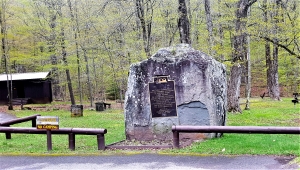Standing stones – Wisdom of the crowd?
The Mountain Eagle – The Catskill Geologists
Robert and Johanna Titus – Oct 26, 2018
Have you ever seen the Devil’s Tombstone? It’s quite a rock—located at Devil’s Tombstone Campground on Rte. 214 near Stony Clove. It’s right next to the highway and there is good parking, so it is easy to get to. Its peculiar name is easy to explain; the rock looks so much like a very large tombstone. However, we doubt that the Devil is buried there.

Such a rock is often called a monolith. It must be about ten feet tall and a few feet thick. It is composed of typical Catskills bluestone. These strata were once sands at the bottom of a Devonian aged river channel. Now these strata make up a boulder, standing on end. But, what exactly is the Devil’s tombstone? It seems that there should be a story here. Well, actually there are several stories. The first one is the most obvious; it is the notion that humans lifted the rock into its current vertical inclination—perhaps for religious or astronomical reasons.
The monolith notion is what scientists call a hypothesis. A hypothesis is an idea which has been advanced as a possible explanation for a scientific problem. A hypothesis needs to be tested through further observations. As more is learned, a hypothesis begins to look better or, if things go poorly, it can become falsified. After being sufficiently tested, a hypothesis may be elevated in science to the level of scientific theory. In science, the word carries a great deal of worth; a theory is considered the highest level of proof in science; it is viewed with great confidence.
But, in science, it is always thought that many hypotheses are better than just one. The more, the better. What about the Devil’s Tombstone? Are there other hypotheses or is the human monolith concept the only one? There is at least one other; boulders of this sort can be the products of ice age activities. Advancing glaciers can be easily imagined as picking up and shoving forward boulders of this size. When a glacier reaches its farthest advance, it will halt and, sometime later, begin melting away. A boulder can be left behind, lying in any inclination. Many will lie at angles less than 90 degrees, but a few, logic tells us, should indeed, be at 90 degrees.
So, which is it? Were standing stones all or mostly all put in place by humans or were all or most of them bulldozed and dropped in place by glaciers? Well, before we decide, we have to learn as much as possible about standing stones and that’s where you come in. Do you know of any standing stones? Can you tell us where to go and see them? Do you know of any leaning stones? We need to see these too; in fact, those may be of more importance.
When we know about these boulders, then we can visit them and ascertain their geologic context. If all of them were found with glacial deposits called moraines, then that would be an indication an ice age origin. If most or all, lie outside of glacial deposits then that would be consistent with the human origin hypothesis.
The point is that all of you can find more of them than just the two of us. When we have a lot of them to look at, then we can gather enough evidence to make a good, sound conclusion—a theory.
So, think about it, we need your help.
==================================================================
Contact the authors at randjtitus@prodigy.net. Join their facebook page “The Catskill Geologist.” Read their blogs at “thecatskillgeologist.com.






There are huge, rounded boulders of all sizes including hundreds of tons found in many places in the world where no glaciers were ever hypothesized. These are indistinguishable from boulders that geologists claimed to be rounded and transported by glaciers. These are found in Kentucky, West Virginia, the Mohave Desert, the Sonoran Desert, Utah, Saudi Arabia, Dubai, several African counties like Namibia, Kenya, the Atacama Desert of South America, Australia, to name a few. Just type in huge desert boulders for instance into a search engine under images, and you will see hundreds of examples. In my view they were made by debris flows. One boulder in Alaska the size of a pickup truck was thrown up 633 feet above sea level in Taan fiord in Icy Bay in Wrangel -St. Elias National Park on October 17, 2015 when the 4th highest tsunami on record shoved it there along with thousands of tons water rounded cobbles all around it. Doubting scientists have gone so far as to absurdly suggest that boulders in the Atacama Desert were shaken smooth by earthquakes.